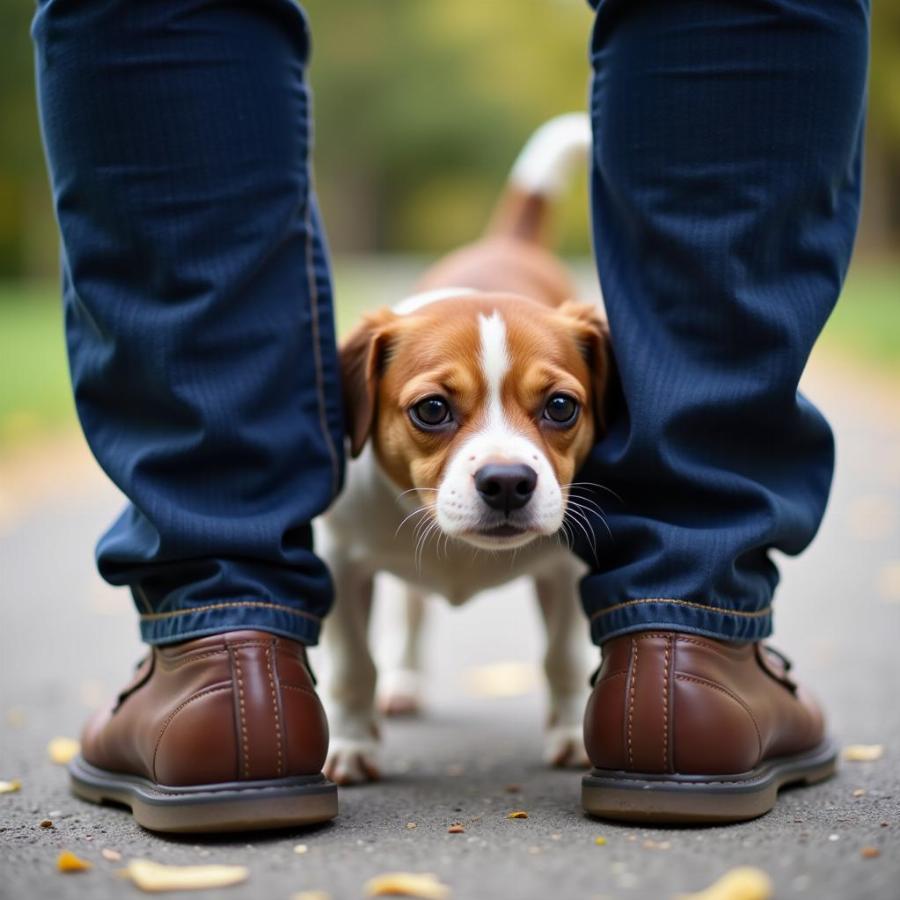The beloved cartoon character Courage the Cowardly Dog, despite his crippling fear of everything, consistently finds himself facing down terrifying monsters and bizarre phenomena. While hilarious on screen, it begs the question: can you actually cultivate courage in a cowardly dog? While we might not encounter talking fungi or a giant chicken from outer space, real-life dog owners often find themselves dealing with fearful behaviors in their furry friends. Let’s explore how to understand, approach, and potentially overcome canine timidity.
Understanding Canine Fear: It’s Not Just Being “Scaredy-Cat”
First, it’s crucial to recognize that fear in dogs isn’t a flaw, it’s a survival instinct. Just like Courage hiding behind Muriel, our dogs have evolved to react to perceived threats. Genetics, early socialization, and individual experiences all contribute to how a dog perceives and reacts to the world. Some common triggers for fear in dogs include:
- Loud Noises: Thunderstorms, fireworks, traffic – these can all send a timid pup scrambling for cover.
- Unfamiliar People or Animals: A new houseguest or a strange dog at the park can be incredibly intimidating.
- New Environments: Even a trip to the vet can be overwhelming for a dog who thrives on routine.
 Dog Hiding Behind Owner
Dog Hiding Behind Owner
Building Confidence, Not Courage: Small Steps for Big Fears
While we can’t erase a dog’s instinctual responses, we can help them build confidence and learn to cope with scary situations. Here are some tips:
- Positive Reinforcement: Just like Muriel’s comforting hugs, rewarding brave behavior is key. Use high-value treats, praise, and gentle petting when your dog approaches a fear trigger calmly.
- Gradual Desensitization: Don’t force your dog to confront their fears head-on. Instead, gradually introduce them to the trigger from a distance, slowly decreasing the distance over time. For example, if your dog is scared of the vacuum cleaner, start by having it off in another room, gradually moving it closer while rewarding calm behavior.
- Counter-Conditioning: The goal here is to change your dog’s emotional response to the fear trigger. When your dog encounters the trigger, pair it with something positive like a favorite toy or a tasty treat. This helps them associate the scary thing with something enjoyable.
When to Seek Professional Help: Because Sometimes, We Need Eustace’s Mask
Sometimes, despite our best efforts, fear can become debilitating for a dog. If your dog’s fear is severe or impacting their quality of life, it’s essential to consult with a certified professional dog trainer or a veterinary behaviorist. They can assess your dog’s individual needs and develop a tailored plan, which may include:
- Medication: In some cases, medication can help manage anxiety and make other training methods more effective.
- Specialized Training Techniques: Professionals can teach you advanced techniques like classical and operant conditioning to help your dog overcome their fears.
Courage Beyond the Cartoon: Embracing Our Dogs, Quirks and All
While we might not be able to transform our cowardly canines into fearless adventurers, we can certainly help them live happier, more confident lives. Remember, understanding the root of their fears, using positive reinforcement, and seeking professional help when needed are the keys to nurturing a strong bond built on trust and understanding.
what kind of dog is scrappy doo can offer insights into different breed temperaments and how they might influence a dog’s behavior.
FAQs: Answering Your Questions About Fearful Fidos
Q: My dog is scared of everything. Is this normal?
A: While all dogs experience fear, extreme fearfulness can indicate an underlying issue. Consulting with a vet or behaviorist is recommended.
Q: How long does it take to help a dog overcome their fears?
A: It varies depending on the severity of the fear, the dog’s individual personality, and the consistency of training. Patience and persistence are key!
Q: Can I use punishment to stop my dog’s fearful behavior?
A: Never! Punishment will only make the fear worse and damage your bond. Always focus on positive reinforcement and building trust.
Looking for More Tail-Wagging Tips?
Check out these other helpful articles on Beaut Dogs:
- [Insert article title related to dog training or behavior here]
- [Insert another relevant article title here]
Beaut Dogs is your go-to resource for all things canine! We provide reliable, insightful information to help you understand and care for your furry companions. For personalized advice and guidance, contact our team at [email protected]. We’re here to help you and your dog live your best lives together!